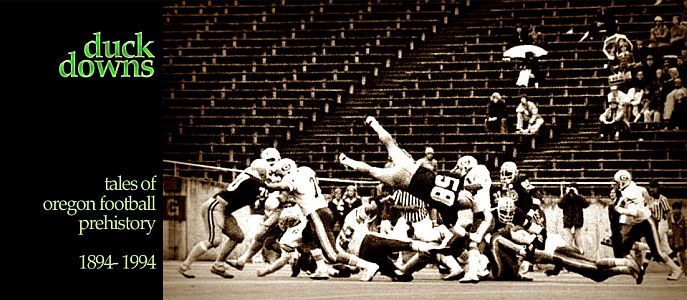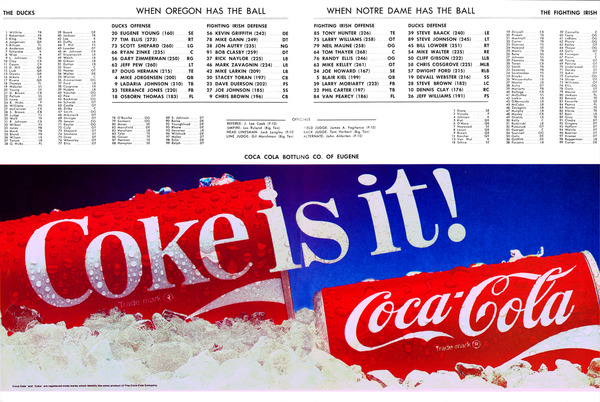October 25, 1982 – Notre Dame at Oregon
 November 4, 2011
November 4, 2011 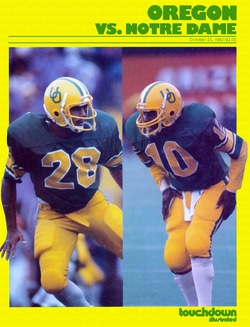 click to embiggenEugene, Oregon had never seen anything like the invasion of die-hard visiting college football fans that hit it in late October of 1982.
click to embiggenEugene, Oregon had never seen anything like the invasion of die-hard visiting college football fans that hit it in late October of 1982.
Once upon a time, the mere utterance of two words could conjure up images in the mind of the listener a glorious football tradition spanning generations. That status is somewhat diminished in the 21st century – scholarship limits, parity, admission standards and a couple of decades of bad coaching can rip the heart out of any dynasty – but in the early 1980s, Notre Dame was still living on its status as a member of the “Old Gang of Nine,” the schools that had dominated college football since the end of World War II.
You could stop any random person on the street of any city in America – perhaps the world – and ask them to name *one* American football team, and odds were that it would be the Fighting Irish of Notre Dame. It was a tradition unlike any other in sports.
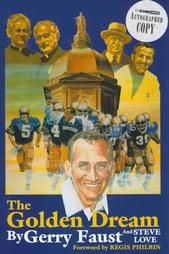 Gerry Faust was well into his second season at the helm of the Domers, and it was already clear that the ability to dominate high school football in Ohio for 18 years, as Faust had at Massillon High, had not automatically translated into success at the top of the next level. After being touted by more than one pundit for a national championship in 1981, Notre Dame under Faust instead stumbled its way into their first losing season since 1963. The 5-6 record left Faust deflated and Irish fans frustrated and impatient. The last game, a 37-15 beatdown at probation-bound Miami, left Faust with a lump in his throat.
Gerry Faust was well into his second season at the helm of the Domers, and it was already clear that the ability to dominate high school football in Ohio for 18 years, as Faust had at Massillon High, had not automatically translated into success at the top of the next level. After being touted by more than one pundit for a national championship in 1981, Notre Dame under Faust instead stumbled its way into their first losing season since 1963. The 5-6 record left Faust deflated and Irish fans frustrated and impatient. The last game, a 37-15 beatdown at probation-bound Miami, left Faust with a lump in his throat.
“We’ll be back from this,” Faust said. “We learned a lot from this. There’s no doubt about it. We’ll be back.”
He was trying to smile but it looked like he wanted to cry.
- Chicago Sun-Times 11/29/1981
By 1982 the pundits had cooled, considerably:
… it’s hard to see Notre Dame doing any better than 7-4 this season. That holds, no matter how firm a grasp Faust gets on things this time around… [In 1981] things got so bad at Notre Dame that for the first time in years there was bickering and grumbling in the locker room, the players openly doubting the coach. Their goal ultimately became not winning but getting to the end of the season without embarrassing themselves. They accomplished neither.
- Sports Illustrated 1/1/1982
But at least people were still talking about Notre Dame. There was still potential that some of that thunder would be shaken down from the sky.
**
The fans of their opponents on October 25, 1982 might have seen a seven win season as cause for parades down Willamette Street.
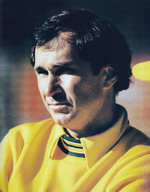 Rich Brooks, 1982 Oregon Media GuideNobody was talking about Oregon after 1981, a season in which Rich Brooks had popped off to the media that his team would be competing for a conference championship, daring the writers to put them in the Top 20, and went out and lost its first game at Fresno State. Brooks saw his injury-riddled team flail through seven straight losses, including being outscored 81-10 in consecutive games at Wazzu and Stanford. Only a sixth straight Civil War victory salvaged any pride out of a 2-9 campaign.
Rich Brooks, 1982 Oregon Media GuideNobody was talking about Oregon after 1981, a season in which Rich Brooks had popped off to the media that his team would be competing for a conference championship, daring the writers to put them in the Top 20, and went out and lost its first game at Fresno State. Brooks saw his injury-riddled team flail through seven straight losses, including being outscored 81-10 in consecutive games at Wazzu and Stanford. Only a sixth straight Civil War victory salvaged any pride out of a 2-9 campaign.
Oregon was back on NCAA probation for the 1982 season, with no TV or postseason play. This was, on the surface, “ironic probation.” The Ducks were rarely on TV during those years anyway, and back then you had to be a relatively good team to get into a bowl game. What hurt more was a cut in available scholarships, from 30 to 25 for 1982 and 28 for 1983. A team with little depth would find itself even thinner for a couple of seasons.
Even victories in recruiting were seemingly tainted. Highly recruited tailback Kevin Willhite, who had surprised just about everyone by signing with the Ducks over Washington in February of 1982, re-injured his hamstring in fall camp and was redshirted. Brooks had a team with little depth, no offensive firepower, no reliable starter at QB, and a defense with talented athletes who weren’t getting it done.
Coming into week seven, the Ducks were 0-6, hadn’t scored a TD on offense until the 4th game of the season, had only managed 56 points while giving up 147, and had lost at home to both San Jose State and Fresno State, the latter 10-4. There were more than a few boosters wondering whether Brooks should be replaced. AD Rick Bay was getting letters and phone calls, not of a congratulatory tone. Brooks was being accused by members of the LA media of having a problem communicating with minority players, a charge he vehemently denied.
And the truth was that the team was improving. The improvements didn’t show on the scoreboard – they had led in the 4th quarter in Seattle before falling to the #1 Huskies – but Brooks thought his team was better than it looked on the field.
Which was heartening, considering how few fans there were at Autzen to watch those first three home losses. The stadium was half-empty every Saturday. But Bay had budgeted for low attendance, and the department was breaking even.
The visit by Notre Dame put the athletic department budget over the top in a big way. The game didn’t sell out – officials blamed a $4 surcharge for keeping the crowd down to 40,381 – but it was still the largest crowd for a non-conference game in state history. Even after turning over $160,000 to Notre Dame as its share of the gate, Oregon cleared almost $270,000, more than it had made on the last full house, the 1981 Washington visit.
It was Notre Dame’s first visit to the Pacific Northwest since a trip to Seattle in 1949, and the story of its scheduling was poignant. In 1969, the then-AD of Notre Dame, Moose Krause, came to Oregon to attend the funeral of Mark Brandt from Grants Pass, an Irish player. Local lumberman and Oregon booster Peter Murphy, a ND alum, and Oregon then-AD Len Casanova showed Autzen Stadium to Krause, and asked him what it would take to get the Irish to Eugene. Each side eventually guaranteed the other $100,000, and the meeting led to an agreement for a home-and-home series. The opener, in South Bend in 1976, saw a 41-0 ND victory. And then, thirteen years after hatching the concept, the thirteenth-ranked Irish (4-1 after a home loss to Arizona) returned the favor.
 Pep rally, Eugene Convention CenterAs soon as the game in Eugene was finalized, the rush on lodging for the weekend began. The Irish received a huge allotment of tickets – 12,000 – and sold all but a few hundred. Notre Dame’s alumni association bought out the entire Eugene Hilton – all 275 rooms – for the week of the game. Every available first-class room from Portland to Cottage Grove was booked solid, all 2700 of them, at premium rates, weeks in advance. The Orange County Notre Dame Club chartered a Boeing 727 for the trip. There was a huge pep rally at the new Eugene Convention Center. A group of 62 fans from Calumet, Indiana, who couldn’t get tickets to games in South Bend, arrived via chartered aircraft. A 75-member delegation of Irish fans from Anaconda, Montana, started drinking on Thursday and seemingly never stopped. Local restaurants reported land-office business; some doubled their normal food and drink sales for an October weekend. Shopping malls and department stores? Jammed with customers. The
Pep rally, Eugene Convention CenterAs soon as the game in Eugene was finalized, the rush on lodging for the weekend began. The Irish received a huge allotment of tickets – 12,000 – and sold all but a few hundred. Notre Dame’s alumni association bought out the entire Eugene Hilton – all 275 rooms – for the week of the game. Every available first-class room from Portland to Cottage Grove was booked solid, all 2700 of them, at premium rates, weeks in advance. The Orange County Notre Dame Club chartered a Boeing 727 for the trip. There was a huge pep rally at the new Eugene Convention Center. A group of 62 fans from Calumet, Indiana, who couldn’t get tickets to games in South Bend, arrived via chartered aircraft. A 75-member delegation of Irish fans from Anaconda, Montana, started drinking on Thursday and seemingly never stopped. Local restaurants reported land-office business; some doubled their normal food and drink sales for an October weekend. Shopping malls and department stores? Jammed with customers. The 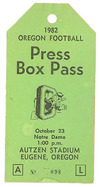 Eugene convention bureau estimated the visitors spent over $1.5 million.
Eugene convention bureau estimated the visitors spent over $1.5 million.
The visitors even rented the Marist High School Marching Band for the entire weekend, running it from the top floor of the Eugene Hilton to the lobby, one floor at a time, playing the Notre Dame fight song non-stop on Friday afternoon, then again on Saturday morning. Their compensation? Tickets to the game.
The Oregon athletic department processed over 100 requests for media credentials, more than double the normal volume.
**
Some of Oregon’s players were unimpressed.
“I think it’s been blown way out of proportion … It’s no different than playing USC or Washington or any other ranked team. It’s sure not the biggest game of my life.”
— OG Gary Zimmerman
But others were more respectful.
“Playing Notre Dame is like a dream … they were the team I always read about when I was a little kid.”
— LB Dwight Ford
Coming off a heartbreaking loss in Berkeley, where the Bears scored a touchdown in the final seconds to win 10-7, Brooks was as usual faced with his chronic muddled situation at QB. Oft-injured sophomore Mike Jorgenson had finally healed enough to get the start at Cal, only to wind up sidelined with a concussion. Dana Hill, who had briefly quit the team after he was suspended for the Washington game 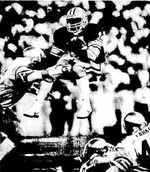 Oregon QB Dana Hill vs NDfor missing a team meeting, was the only QB left with any game experience that Brooks trusted. Senior Kevin Lusk, who in 1981 was seen as the second coming of Dan Fouts but wound up as the reincarnation of Norval Turner, was relegated to third string. Tailback Dwight Robertson’s bad knee was still keeping him out of games, a big problem for the Ducks, one of the nation’s worst passing teams (46 of 115, 446 yards, and just two TDs – one by tailback Harry Billups): Notre Dame had the nation’s #1 rushing defense.
Oregon QB Dana Hill vs NDfor missing a team meeting, was the only QB left with any game experience that Brooks trusted. Senior Kevin Lusk, who in 1981 was seen as the second coming of Dan Fouts but wound up as the reincarnation of Norval Turner, was relegated to third string. Tailback Dwight Robertson’s bad knee was still keeping him out of games, a big problem for the Ducks, one of the nation’s worst passing teams (46 of 115, 446 yards, and just two TDs – one by tailback Harry Billups): Notre Dame had the nation’s #1 rushing defense.
Jimmy the Greek put the Irish as 14 point favorites. The Oregonian’s George Pasero called it closer: 17-14, Irish.
**
Th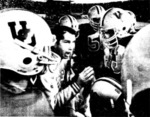 Rich Brooks exhorts the troops, ND 1982e game played out on a cloudy, drizzly afternoon. An early bobble of a snap on a punt by Oregon’s Kevin Hicks put the Irish in position for the first score on the Oregon 30; two runs by Allen Pinkett, and ND was up early. But it was the only touchdown they’d score all day. The Ducks, still touchdown-challenged themselves, managed to score the first points Notre Dame had allowed all season in a first quarter when new placekicker Todd Lee hit his first FG as a Duck to pull Oregon within 7-3.
Rich Brooks exhorts the troops, ND 1982e game played out on a cloudy, drizzly afternoon. An early bobble of a snap on a punt by Oregon’s Kevin Hicks put the Irish in position for the first score on the Oregon 30; two runs by Allen Pinkett, and ND was up early. But it was the only touchdown they’d score all day. The Ducks, still touchdown-challenged themselves, managed to score the first points Notre Dame had allowed all season in a first quarter when new placekicker Todd Lee hit his first FG as a Duck to pull Oregon within 7-3.
In the immortal words of Lindsey Nelson, “With the score still the same, we move to further action.” The halftime score was 7-3. In the Notre Dame box, Father Edmund Joyce, the school’s executive vice president, was concerned. “I’m concerned,” he said. “I can’t relax.”
It was a game of little offense (the teams combined for 465 yards on 135 plays) and much jockeying for field position. But after trading field goals in the third quarter, the sun came out … and the Ducks appeared to be headed for one of the greatest upsets in team history when, early in the 4th quarter, senior fullback Terrance Jones – who had scored Oregon’s final touchdown in a tie game against USC two years earlier – bowled into the end zone from a yard out, giving the Ducks a 13-10 lead with just over ten minutes left. Jones’ effort, after Mike 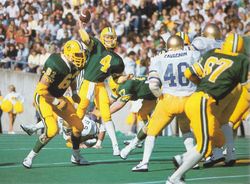 Jorgensen passes to TE Doug Herman in the 2nd half. (source: Oregon Football 1894-1995)Jorgensen hit Osborne Thomas for 23 yards on a leaping catch, capped an 80 yard drive in 10 plays, the best drive by either team all day to that point.
Jorgensen passes to TE Doug Herman in the 2nd half. (source: Oregon Football 1894-1995)Jorgensen hit Osborne Thomas for 23 yards on a leaping catch, capped an 80 yard drive in 10 plays, the best drive by either team all day to that point.
The upset wasn’t to be. After several three-and-outs by each team, maligned ND senior quarterback Blair Kiel led the Irish on its only decent drive of the game. Starting with 84 seconds and no timeouts remaining, Kiel managed a 10-play, 73-yard drive, hitting 4 of 4 passes against Oregon’s “prevent” defense. The Ducks weren’t pressuring the QB, and Kiel kept hitting his targets on sideline routes. The drive stalled on the Oregon 18, when the Ducks finally came out of the prevent and started sending Dwight Ford and DE Mike Walter after Kiel; both barely missed sacks that might have made a FG impossible.
Finally the Irish turned to their kicker, Mike Johnston, who hadn’t missed all season and didn’t miss this one, nudging through a 35-yarder as time expired.
Final score: 13-13.
**
“I thought we outplayed them and deserved to win,” a dejected Coach Brooks said after the game. “They were the ones who had to elect to take a tie.”
“We are happy to salvage at least a tie,” Faust countered. “We would have liked a touchdown, but time ran out on us. We’ve got too much at stake to throw it away. We didn’t have much choice.”
The strange economics of perception in the world of college football made a tie look better at the end of the year than a loss, and for a team like Notre Dame, which at the time was a lock for a major bowl bid any time it won eight games, a loss was the worst thing imaginable. Especially with games upcoming against USC and Miami. But it must have been shocking to the football world in general, and the Irish entity in particular, to think that the odds against scoring a touchdown against Oregon were so great that they had to settle for a last-second field goal and a 13-13 tie.
Ultimately, the difference in a game that had no difference on the scoreboard could have been two missed Oregon field goal attempts. Oregon was 2-4; Notre Dame 2-2.
Brooks wouldn’t apologize for defensive coordinator Andy Christoff’s decision to use the prevent on that last drive.
“Hell, no. We just as easily could have come up with an interception. We tried it earlier and it worked… Give them credit for making a few big plays at the end.”
And give the Ducks credit in the end as well.
The media tried to talk us into being awed by Notre Dame, but we weren’t going to have any of that… In some cases they line up with better people than we do, but in others they don’t.
I told the team on each play they’re lining up against one man, not the Four Horsemen.”
— Rich Brooks
**
The game was one of the few highlights of Oregon’s 2-8-1 campaign in 1982. The Ducks remained winless until week ten, when Arizona – who had beaten the Irish in South Bend – came to Autzen as 17 point favorites, and lost 13-7; and the ritual beating of OSU, 7-6 in Corvallis, gave the team its first winning streak in two seasons.
It’s fair to say that 1982 was the nadir of The Suffering. The chart of the rest of Brooks’ career at Oregon shows steady performance and gradual improvement, with the occasional bubble and correction over the next twelve seasons.
Getting out from under probation, and the associated scholarship limits, helped. So did NCAA changes that limited the ability of teams to stockpile players on 120-man rosters, using scholarships from non-revenue sports. And as television markets finally opened up following a 1984 Supreme Court decision, the revenue stream improved.
1982 was as bad as The Suffering got, the 1983 Civil War notwithstanding. And if a tie is, as they say, like kissing your sister, the Notre Dame tie was like kissing your really hot step-sister who you haven’t seen since ten years ago when she was only nine and your parents divorced again and you can close your eyes and pretend she’s not your sister. She might not like it, but she’s hot, and she’s leaving town tomorrow, and you’re desperate.
**
Notre Dame finished 1982 at 6-4-1, with three straight losses to Penn State, Air Force and USC to end the season. No bowl game. Faust resigned before the last game of 1985; Miami sent him off with an infamous 58-7 loss. Lou Holtz took over the Irish, and within three seasons Notre Dame had won another national championship.
Faust returned to coach in Ohio, taking over the Akron Zips. He retired in 1994, after going 1-10 in his ninth season. He never won more than seven games in a regular season as a college coach.
**
Program Notes:
- Cover athletes: DB Steve Brown (28) and CB Dennis Clay (10).
- Nike football shoes haven’t always been gorgeous. I’d say their design standards have been significantly upgraded over the past 30 years.
- Here’s a fun project! Count the ads for airlines that no longer exist.
- There’s a two-page look at Jim Haney’s last Oregon basketball team, which performed pretty much like all the others under Jim Haney; his teams never won a game they weren’t favored to win.
- Note the subtle sexual appeal of the Coors Light ad. Coors Light was a relatively new brand that hadn’t yet found its market; in the early 80s, light beers had not acheived mainstream popularity, if you know what I mean. (Irony: You couldn’t buy any Coors product in the state of Oregon in 1982 because of an archaic law that required beer to be pasteurized. The law was overturned in 1985.)
- See the “Oregon’s Offensive Coaches” page? See Steve Greatwood sporting his Afro? If you see him on the sidelines, ask him about it. 1982 was his first season as a full-time coach.
